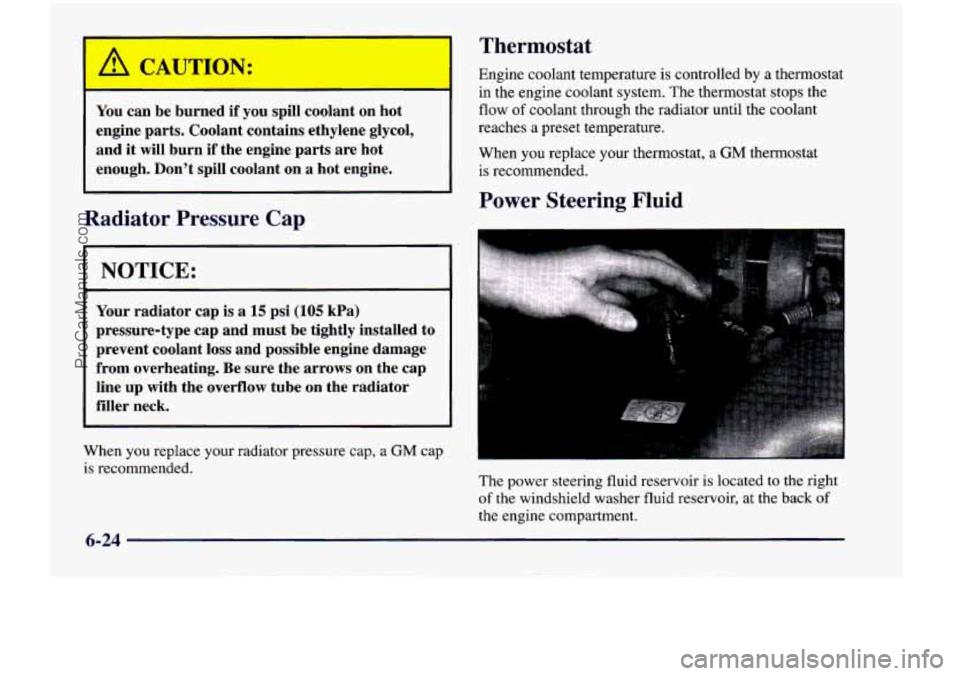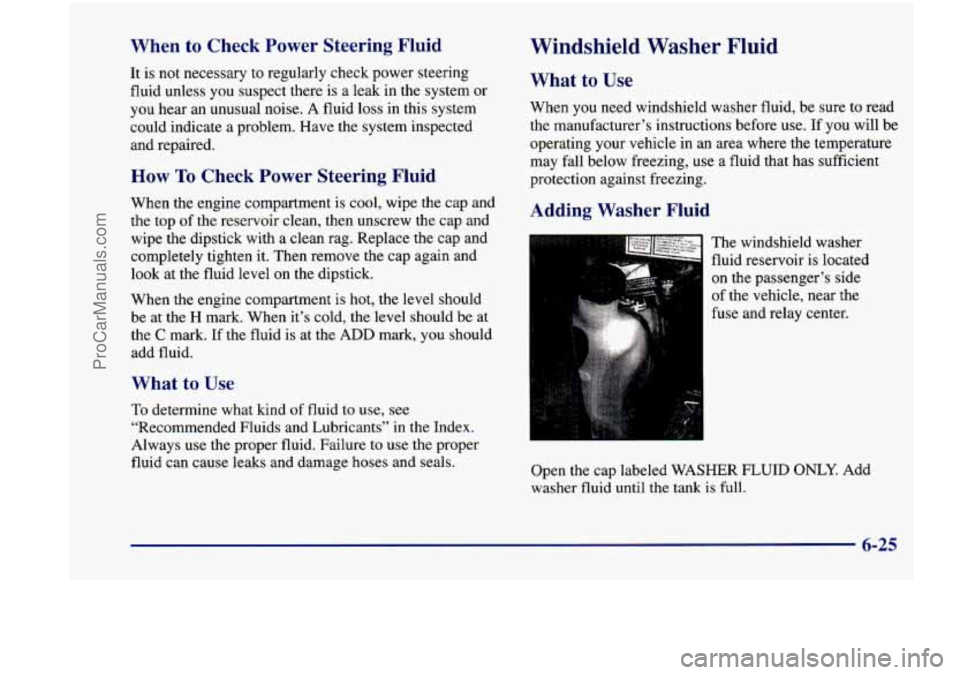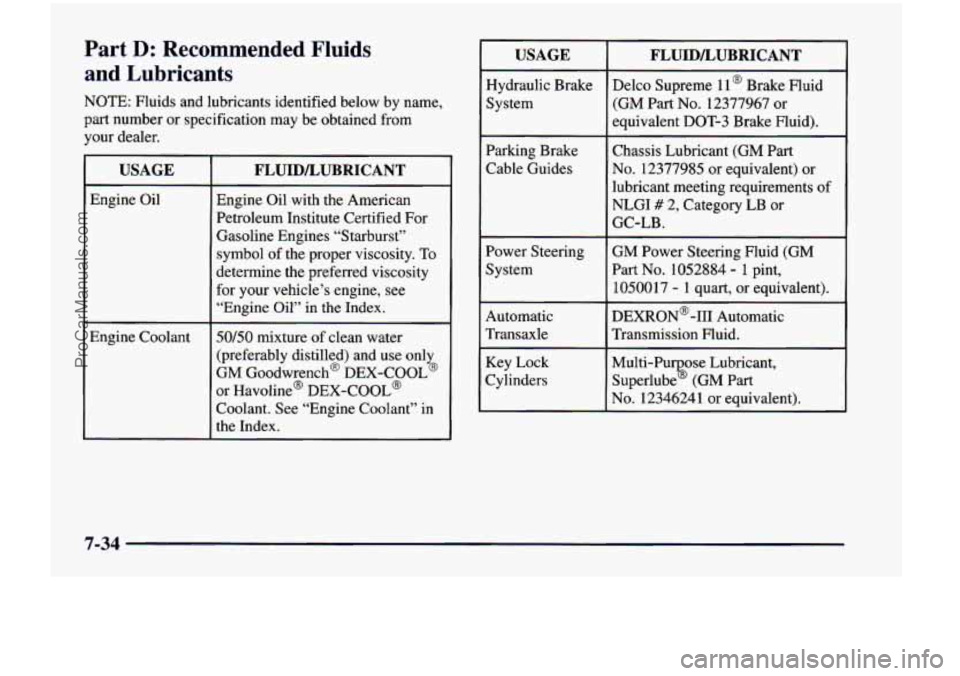Page 345 of 474
When you lift the hood, you'll see these items:
rn
A. Underhood Fuse and D. Radiator Pressure Cap H. Transaxle Fluid Dipstick
B. Remote Positive (+) Terminal
C. Windshield Washer
Fluid Reservoir Relay Center
E. Power Steering Fluid Reservoir I. Brake Master Cylinder
E Engine Oil Fill Location J. Air Cleaner
G. Engine Oil Dipstick K. Engine Coolant Reservoir
6-10
ProCarManuals.com
Page 359 of 474

Thermostat
Engine coolant temperature is controlled by a thermostat
in the engine coolant system. The thermostat stops the
flow
of coolant through the radiator until the coolant
reaches a preset temperature.
You
can be burned if you spill coolant on hot
engine parts, Coolant contains ethylene glycol,
and
it will burn if the engine parts are hot
enough. Don't spill coolant on
a hot engine.
Radiator I ressure Cap
NOTICE:
Your radiator cap is a 15 psi (105 kPa)
pressure-type cap and must be tightly installed to
prevent coolant
loss and possible engine damage
from overheating. Be sure the arrows on the cap
line up with the overflow tube on the radiator
filler neck.
When you replace your radiator pressure cap,
a GM cap
is recommended. When you replace your thermostat, a
GM thermostat
is recommended.
Power
Steering Fluid
'l'kv Gower steering fluid reservoir is located to the right
of the windshield washer fluid reservoir, at the back of
the engine compartment.
ProCarManuals.com
Page 360 of 474

When to Check Power Steering Fluid
It is not necessary to regularly check power steering
fluid unless you suspect there is a leak in the system or
you hear an unusual noise. A fluid
loss in this system
could indicate a problem. Have the system inspected
and repaired.
How To Check Power Steering Fluid
When the engine compartment is cool, wipe the cap and
the top of the reservoir clean, then unscrew the cap and
wipe the dipstick with a clean rag. Replace the cap and
completely tighten it. Then remove the cap again and
look at the fluid level on the dipstick.
When the engine compartment
is hot, the level should
be at the
H mark. When it’s cold, the level should be at
the
C mark. If the fluid is at the ADD mark, you should
add fluid.
What to Use
To determine what kind of fluid to use, see
“Recommended Fluids and Lubricants” in the Index.
Always
use the proper fluid. Failure to use the proper
fluid can cause leaks and damage hoses and seals.
Windshield Washer Fluid
What to Use
When you need windshield washer fluid, be sure to read
the manufacturer’s instructions before use. If you will be
operating your vehicle in an area where the temperature may fall below freezing, use
a fluid that has sufficient
protection against freezing.
Adding Washer Fluid
on the passenger’s side
of the vehicle, near the
fuse and relay center.
Open the cap labeled WASHER FLUID
ONLY. Add
washer fluid until the tank is full.
6-25
ProCarManuals.com
Page 437 of 474

Part D: Recommended Fluids
and Lubricants
NOTE: Fluids and lubricants identified below by name,
part number or specification may be obtained from your dealer.
USAGE FLUIDLUBRICANT
Engine Oil Engine Oil with the American
Petroleum Institute Certified For
Gasoline Engines “Starburst” symbol of the proper viscosity.
To
determine the preferred viscosity
for your vehicle’s engine, see
“Engine Oil” in the Index.
Engine Coolant
50/50 mixture of clean water
(preferably distilled) and use only
GM Goodwrench@
DEX-COOL@
or Havoline@ DEX-COOL@
Coolant. See “Engine Coolant” in
the Index.
USAGE
Hydraulic Brake
System
Parking Brake
Cable Guides
Power Steering
System Automatic
Transaxle
Key Lock
Cylinders
FLUIDLUBRICANT
Delco Supreme ll@ Brake Fluid
(GM Part
No. 12377967 or
equivalent DOT-3 Brake Fluid).
Chassis Lubricant (GM Part
No. 12377985 or equivalent) or
lubricant meeting requirements
of
NLGI # 2, Category LB or
GC-LB.
GM Power Steering Fluid (GM
Part
No. 1052884 - 1 pint,
1050017
- 1 quart, or equivalent).
DEXRON@-111 Automatic
Transmission fluid.
Multi-Pu ose Lubricant,
Superlube
% (GM Part
No. 1234624 1 or equivalent).
7-34
ProCarManuals.com